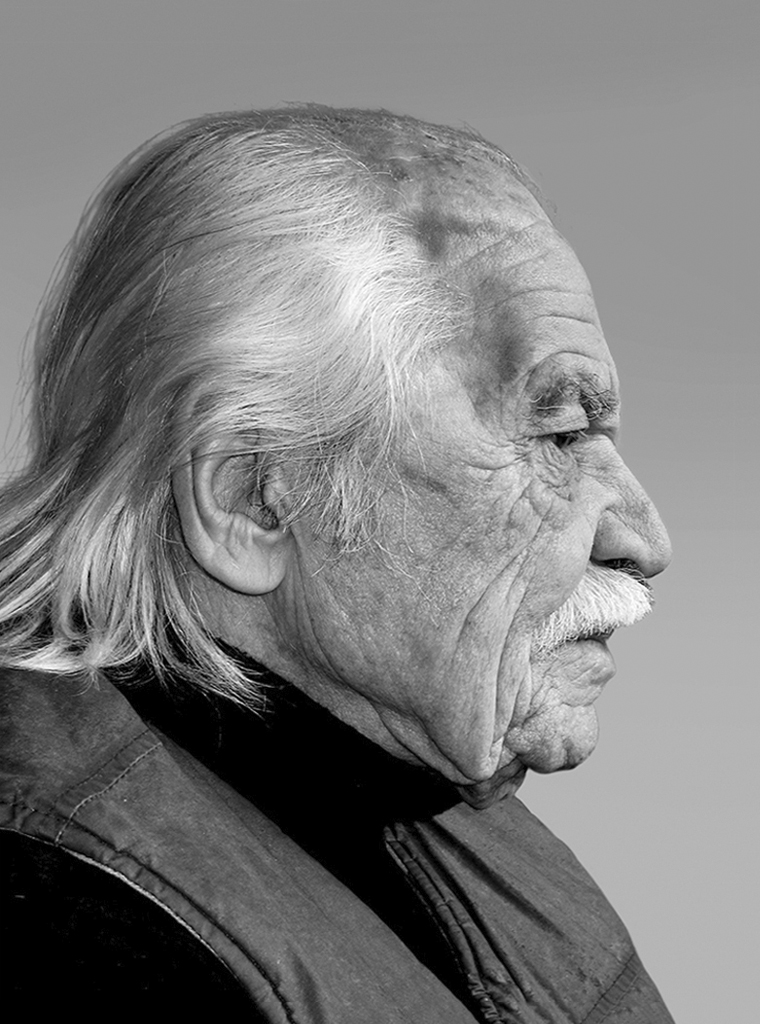It is the end of February 2006. I just received the portraits of Benno made by Jan van Toorn during his visit to Providence, Rhode Island. Stylistically, they are perfectly matched with the profiles created by Aatjan Renders for the Roots publications. The winter of 2005-06 on the East Coast of the United States had been especially wild with snowfalls of up to half a meter. Writes his devoted wife Jannie: ‘Visiting the barber was out-of-the-question. Benno’s spikes will have to wait. His wheelchair is no match for the snow’.
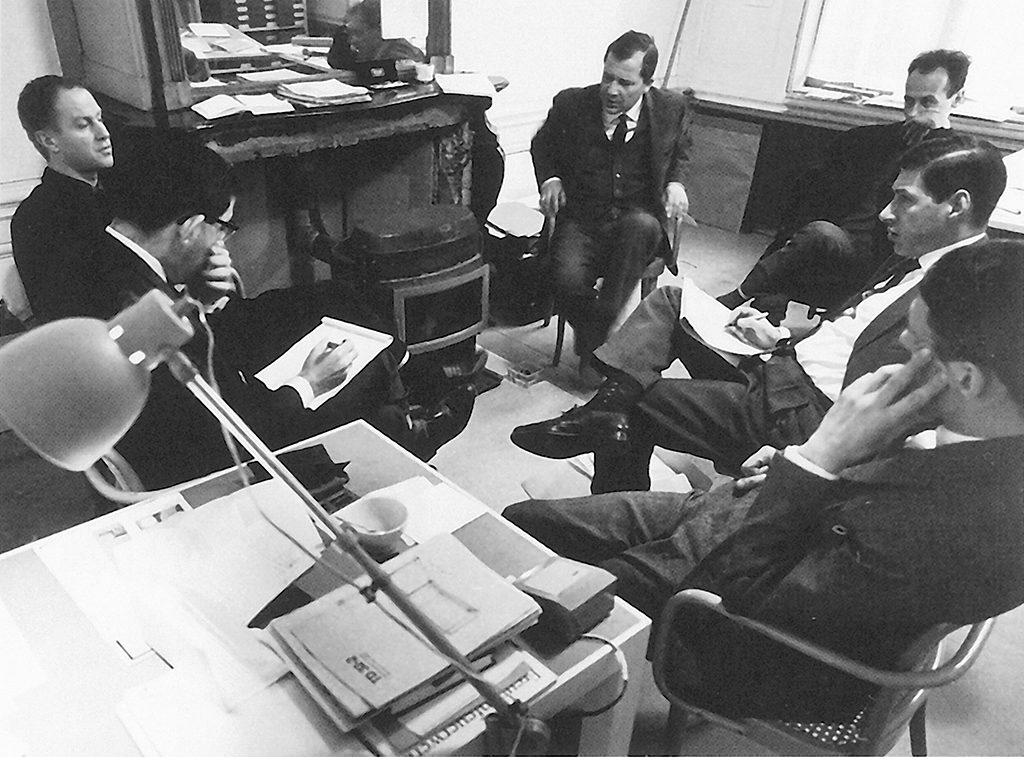
Minutes Recorder with hand at mouth: Dick Schwartz. In addition left to right:
Friso Kramer, Benno Wissing, Ben Bos, Paul Schwartz, Wim Crouwel in the foreground
After a celebrated and eventful design career in the Netherlands, Benno Wissing (1923-2008) and family settle in 1980 in the small coastal town of Bristol, Rhode Island on the east coast of the United States. It is to be the next chapter in a colorful life in search of social engagement and creative problem solving. Ten years later he suffers a stroke, severely limiting his mobility. His professional career as a graphic and environmental designer comes to an abrupt halt. Undaunted, and with courage, the Wissings carry on. Over time, new and troubling physical problems emerge.
Reflecting on his rich and varied career Benno, the eternal optimist, finds inspiration in the changing seasons of his new world: he returns to his artistic roots, and resumes creating beautiful drawings and watercolors.
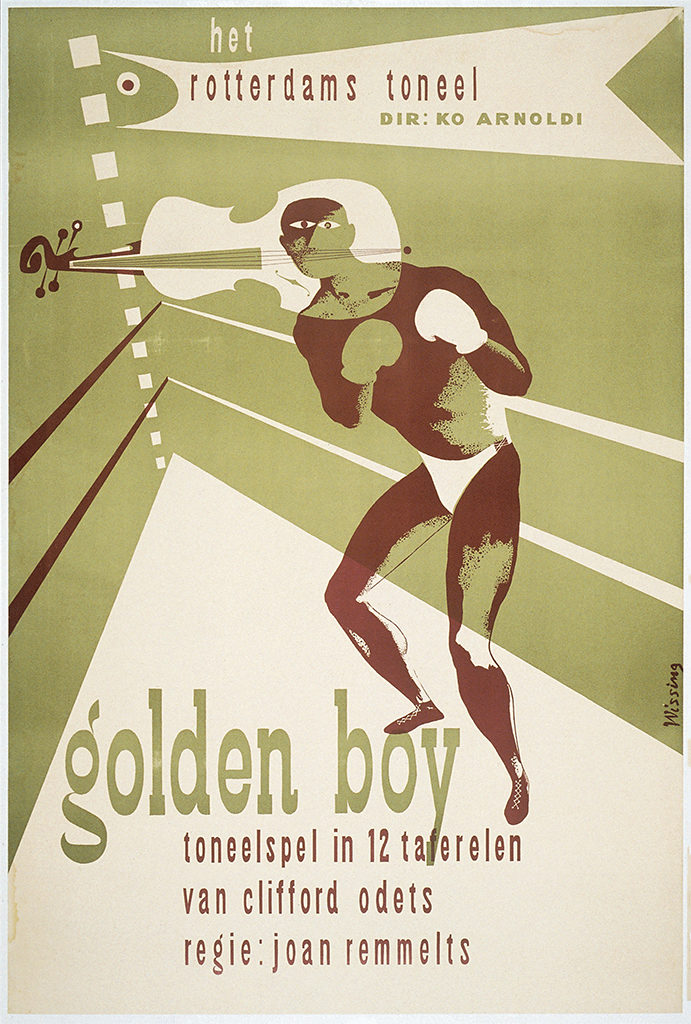
Benno was the grandson of a Groningen country preacher and the son of a candidate-solicitor and chief inspector for an insurance company. When he was enrolled at the Erasmiaans Gymnasium in Rotterdam his mother unleashed a graphologist on him. The analysis cannot have been anything but perfect as a review of a short half-century of his professional life and work bear out. The results connected seamlessly with the character traits and qualities of Benno Wissing: willpower, endurance, steadfastness, unimpressionable, imaginative, immersive, discreet, businesslike, self-contained, passionate – in possession of a sober mind, but sometimes also intuitive and anarchic.
The Second World War drastically alters the life of the public schoolboy. The German occupier commandeers the school building and learning is moved to private quarters. And frankly, Benno has had it after 5 years ‘Erasmus’. Influenced by his Jewish friends he becomes interested in literature, delves into Kafka among others, and tries his hand at poetry. Fear and unrest reigns in the severely damaged, occupied Rotterdam. Benno transfers these feelings into drawings and paintings. He is seized by the fate of the Jewish community. In 1941 he enrolls at the Rotterdam Art Academy. From that time on he is a friend with Jan Begeer, whose father is an art critic. Through him the young Wissing is introduced to the work of Peter Alma, Paul Klee and the photograms of Moholy-Nagy. Benno and Jan visit the designer/artist Dick Elffers (who shows them the ‘hot prints’ of H.N. Werkman) and the painter Dolf Henkes.
Things are not well at the academy. They are so bad that Benno takes it upon himself to instruct his fellow students after which he is no longer welcome at school. Jan Begeer and Benno try to escape from the occupying forces and succeed in reaching Marseille, by way of Paris, en-route to freedom. But the harbor of Marseille, in the unoccupied Vichy part of France, is after all locked-down by the Germans. Instead, they survey lots of regional art, and in the end return to Paris. In the wake of the maquis, the local resistance, they experience life-threatening adventures and find themselves even in the line of German gunfire. Jan is wounded for life. They escape the embrace of the occupier and find work making theatre sets. At the end of 1944 they manage to find a way through the enemy lines and return to Rotterdam –only to have to endure the ordeal of the arctic ‘hunger-winter’.
Half a year later liberation has arrived and the largest challenge is to rebuild Rotterdam, physically as well as psychologically. Artists embrace the challenge. Benno meets the writers Cor Veendrager and Hans Sleutelaar, as well as the architect Herman Haan. It is the start of enduring friendships. A group associated with the cultural center ‘Ons Huis’ (Our House) proposes to rebuild part of this building into a movie theatre and exhibition space. Benno aspires to the commission, but it goes to the architects Van den Broek and Bakema. For him remains the consolation prize of graphic- and sometime later exhibit design. It turns out to be the start of his designer’s career.
Benno develops an interest in Communism. He writes critiques for the communist newspaper De Waarheid (The Truth). To satisfy his curiosity he travels to a youth congress in (Kafka’s) Prague and arrives eventually in (Tito’s) Yugoslavia. However, after writing a careless commentary for United Press about officers in Skopje, he becomes a persona non grata. But before he leaves he has a chance to “sniff at newspapers” which starts his interest for the graphic aspects of information and its delivery.
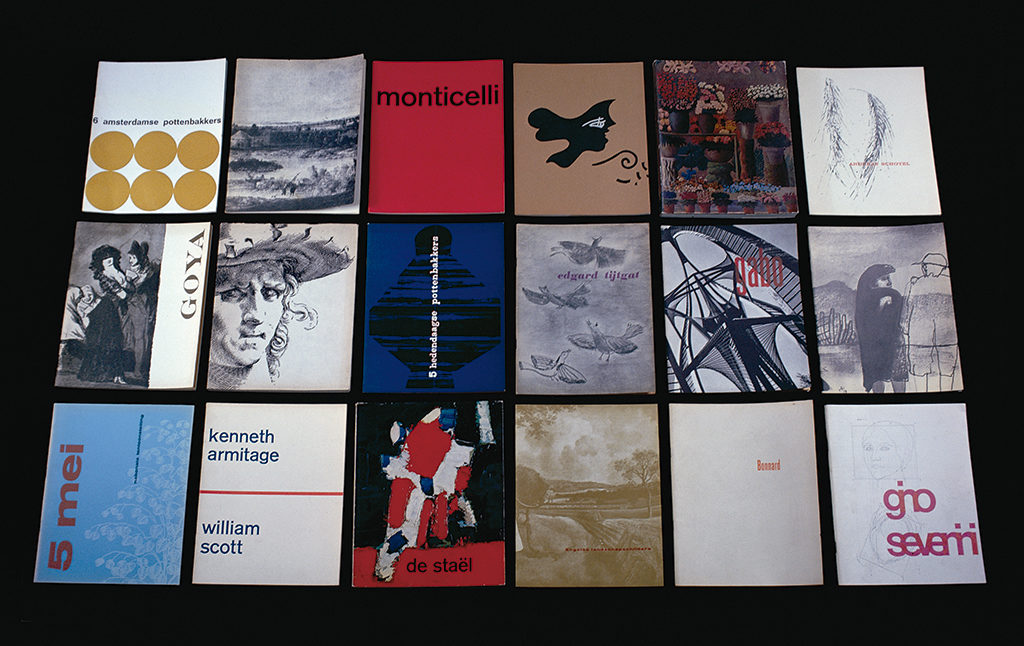
For a short while he keeps on painting, makes lots of beautiful drawings and graphic art. Nonetheless he bids art farewell and focuses on design. For the rebuilding of Rotterdam Benno is the right man in the right place. In essence he is self-taught, but his varied experiences make him into a versatile designer and in 1949 he starts his own practice. His Rotterdam years are strongly colored by his intense involvement with the Museum Boijmans-van Beuningen and the local Municipal Printing company. Between 1949 and 1966 he makes a short hundred posters, catalogues, collection monographs and calendars. He installs exhibits and redesigns the auditorium. The posters belong to the highlights of the Dutch design history. He shares this honor with the illustrious ‘museum designers’: Willem Sandberg, Wim Crouwel, Otto Truemann and Jan van Toorn. A long line of world artists pass through the Boijmans: from Benno’s firsts, ‘Rotterdam Grafiek” and ‘Ossip Zadkine’ to his last, ‘Cobra 1948/51’.
Ebbinge Wubbe, Boijmans’ director, introduces Benno to the Rotterdam Municipal Printing Company. For many years he functions as advisor to its director Jacques van Wijk. He modernizes the type collection, re-educates the printers, and rebuilds the plant giving the company a new lease on life. It allows him to penetrate the Rotterdam establishment. He receives commissions for the Rotterdam Ballet Ensemble, the Philharmonic Orchestra, De Doelen concert- and convention center, the Museum voor Land- en Volkenkunde (Geography and Ethnology Museum), the Erasmus University, the Rijnhotel (the Rhine Hotel), the printing company Plantijn and the Ahoy Events facilities. He retains some hefty industrial clients in Wijnmalen & Hausermann (earth moving equipment) and IGB concrete builders. He designs trade exhibits and lots of printed matter. Terrific ‘parade horses’ in the cultural corner are the literary magazine Gard Sivik and collaborations with Pieter Brattinga’s Steendrukkerij De Jong & Co (stone lithographers). Gard Sivik allows Benno to experiment, to his hearts delight, with typography and unexpected paper stock. The municipal region of Rijnmond receives a strong and picturesque ‘Wissing’ logo. A special relationship develops between Benno and Hendrik de Leeuw, director of the innovative department store Metz & Co. Again he takes on the role of advisor and designs a variety of unique printed sales material, as always enticing feasts for the eyes. Playfulness is revealed in the irresistible fantasy of the artist in Benno Wissing. For a moment there is neither strictness nor dogma in his work. There he shows his (almost) frivolous other side. He becomes very humane and lyrical. Typographically he combines extremes into harmonic co-existences. Wherever it suits him he joins, in lusty embrace, the time-honored sans serif Akzidenz Grotesk (medium) with florid, fleet-footed scripts.
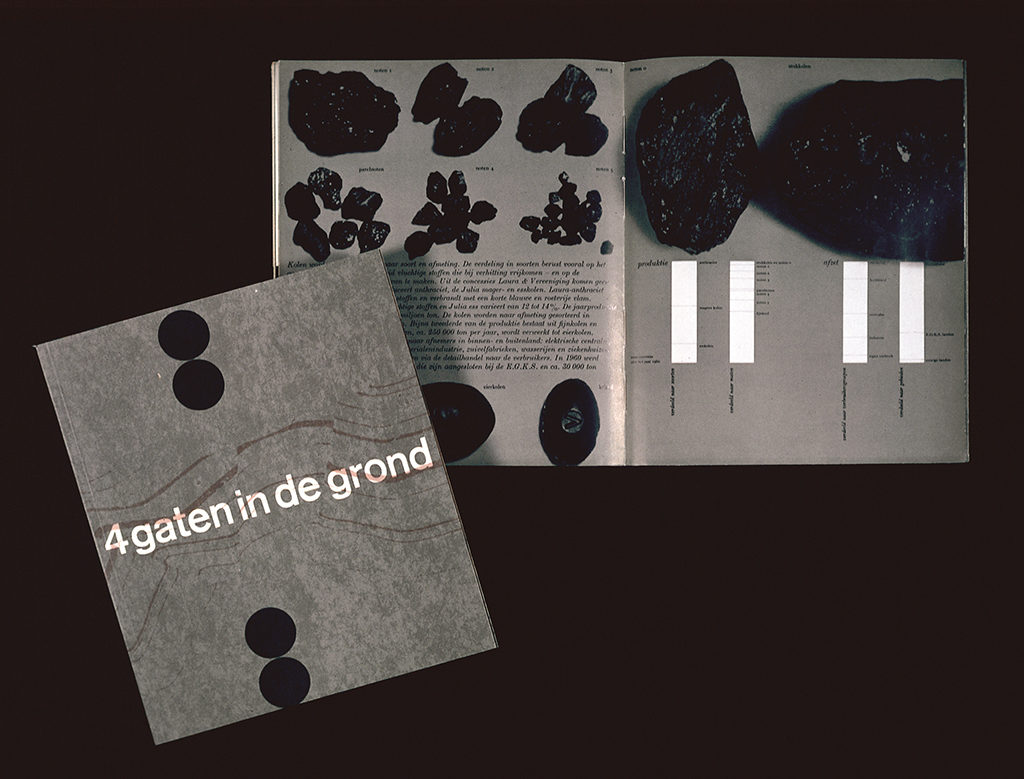
Laura & Vereniging – Photography Carel Blazer
Two more projects are close to Benno’s heart. He makes, together with the photographer Carel Blazer, an extremely beautiful book 4 gaten in de grond(4 holes in the ground) for the Limburg mining corporation ‘Laura en Vereeniging’ (Laura Associates) which was threatened with closure. For the 100-year anniversary of the company Grasso of ‘s-Hertogenbosch, Benno makes a jubilee book in collaboration with his friends the writer Eugène Eberle and the photographer Violette Cornelius.
His most important spatial designs are the pavilions for the exhibit ‘E 55’ (concerning energy) and the ones for the convention and exhibition center the Jaarbeurs in Utrecht. He redesigns the home of Eugène Eberle and builds an apothecary in Ijsselmonde, including a thorough review of and solution for fundamental problems of inventory control – which he will successfully elaborate on in later, similar commissions.His first true introduction to Wim Crouwel takes place at the Utrecht Jaarbeurs where both are engaged with substantial exhibit designs. Subsequently Benno and Wim install, in the mess hall of Steendrukkerij De Jong & Co in Hilversum, a rather original exhibit about the magazine Architectural Review. Time has come for new adventures in the design world. Large and complex problems ask for interdisciplinary collaboration to deliver integrated design solutions. Time for something called ‘Total Design’.
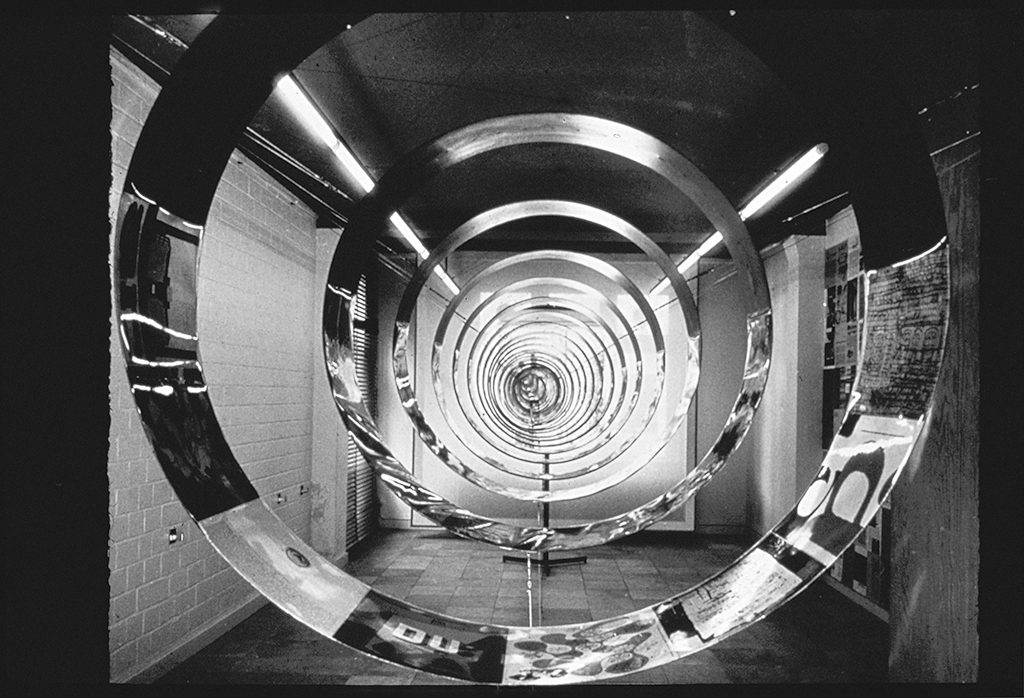
the Steendrukkerij de Jong & Co., Hilversum, with Wim Crouwel
In the run-up to this various important designers gather around the table. Benno Premsela shows interest in the concept. Charles Jongejans is a potential participant, as is the architect and industrial designer Kho Liang Ie (who was until recently Wim Crouwel’s associate). Friso Kramer is interested as are Paul and Dick Schwarz who, after careers in industrial management, are ready to start new lives as business partners of the design group. In the end these last two, together with Benno, Wim and Friso, become the true founders of ‘TD Associatie voor Total Design’ (TD Association for Total Design). They settle in a seventeenth century building at the Herengracht in Amsterdam. I am initially hired as studio manager. The creative partners bring their assistants with them and they form the crew of this studio. That arrangement has a short life. Everyone prefers to rub shoulders with their old masters. So, they abandon the studio and I set up my own design team.
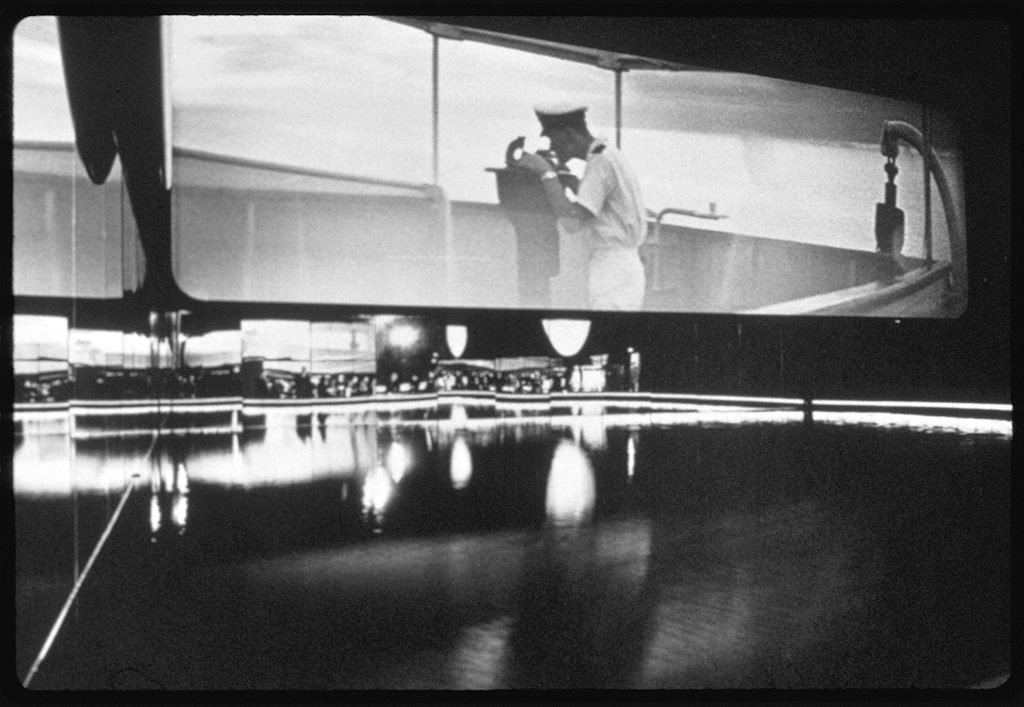
At first Benno works with the graphic designers Leendert Stofbergen, George Koizumi and Haruko Koguchi and environmental designer Roel Zandee. In the following years others participate such as Pieter van Delft, Ine Wijtvliet, Eli Gross, Andrew Fallon, Hartmut Kowalke, Anne Stienstra, Josephine Dam, and John Stegmeijer. Occasionally there are some passersby from the Hochschule für Gestaltung, Ulm, like the German Frank Hess and the Yugoslav Zlatan Medugorac.
In no time Benno becomes ‘Vader Benno’ (Papa Benno). He positions himself as a creative mentor for the people surrounding him providing them with challenges and opportunities. For many it is a sort of post-graduate period. Besides, Total Design schooled an entire generation of offspring, ready to eventually stand on their own two legs or to populate the offices of the competition. Take Andrew Fallon. He arrives as a summer intern and before he knows he creates the foundation for the Calpam logo, which he then gets to perfect with Hartmut and Benno. Later on he finds his own way to Tel Design. Benno is also the ‘party theorist’ for Total Design. He develops diverse systems, which make designing with grids easier: pre-printed transparent sheets in A4 format with varying column widths and line spacing, including typesetting and production instructions.
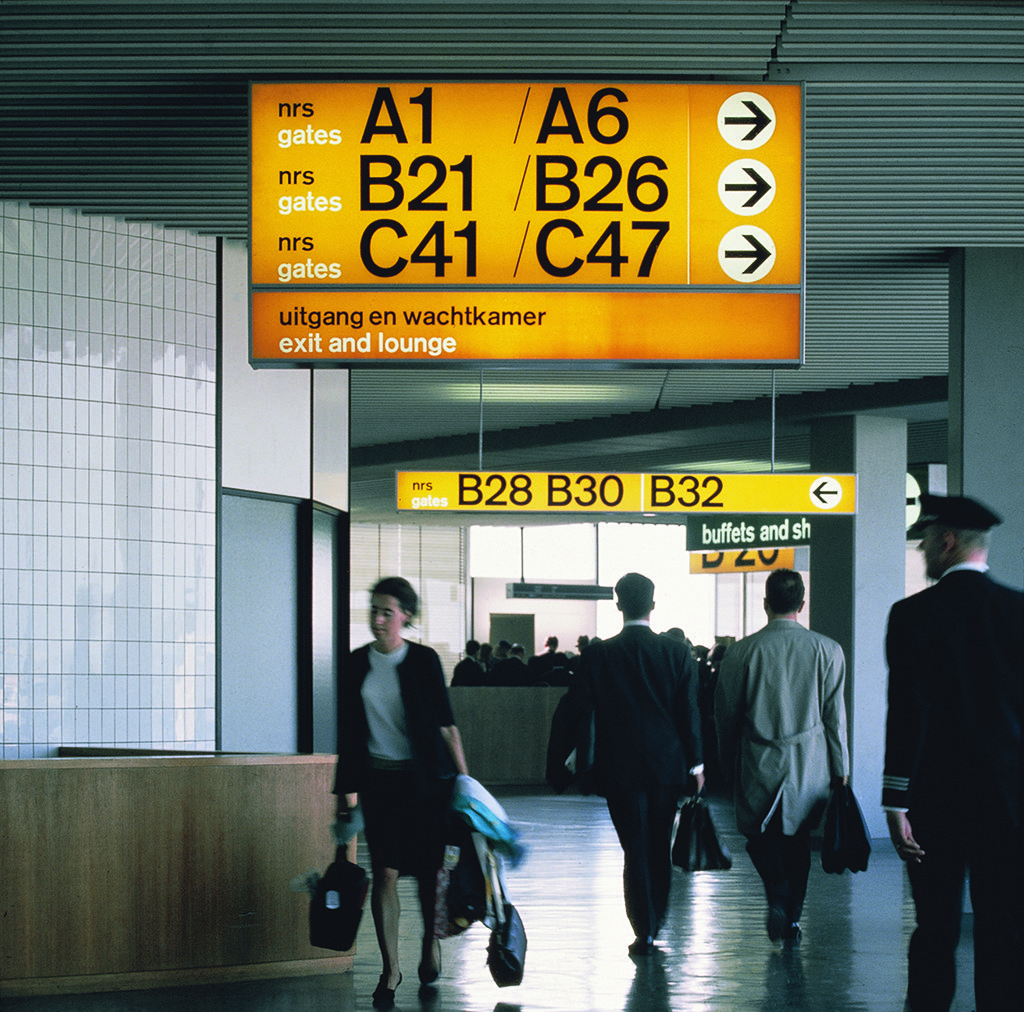
Large challenges present themselves. Together with architect friends Oyevaar Stolle Van Gool they design a national information pavilion named ‘Nederland Transportland’ for the Verkehrsausstellung Münschen (Transportation exhibit Munich). It is an enormous shed in which film and photography are projected in a giant format above a ‘real’ inner sea. A new house style is developed for Auping. For the family of its director Albert Auping, Benno builds a bungalow with industrially produced prefab elements. And then, in 1967, follows the new Schiphol airport. His friend Kho Liang Ie is responsible for the interior design and he invites Benno to design for the efficient direction of the streams of coming-and-going passengers. At the time, on large international airports, many passengers ‘got lost’ and missed their flight or connection. For many years thereafter Benno’s wayfinding and signage design becomes a kind of blueprint for all airports who had to accommodate the jumbo jets with its mass of passengers. He creates a system of visual and auditory signs supported with clear typography and memorable colors for terminals, gates, and Jetways.
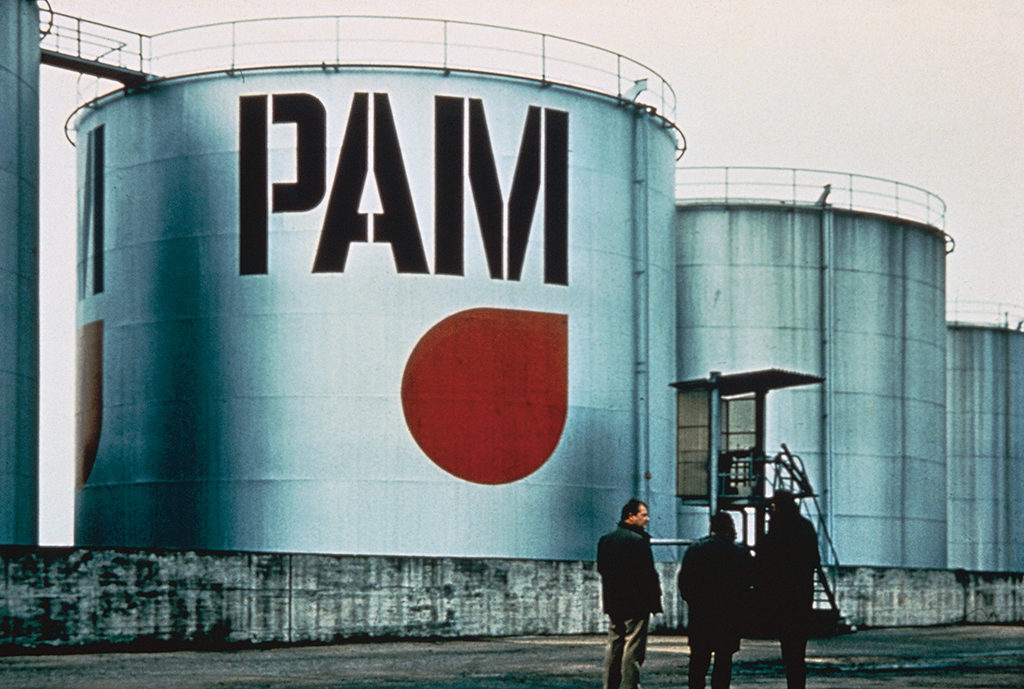
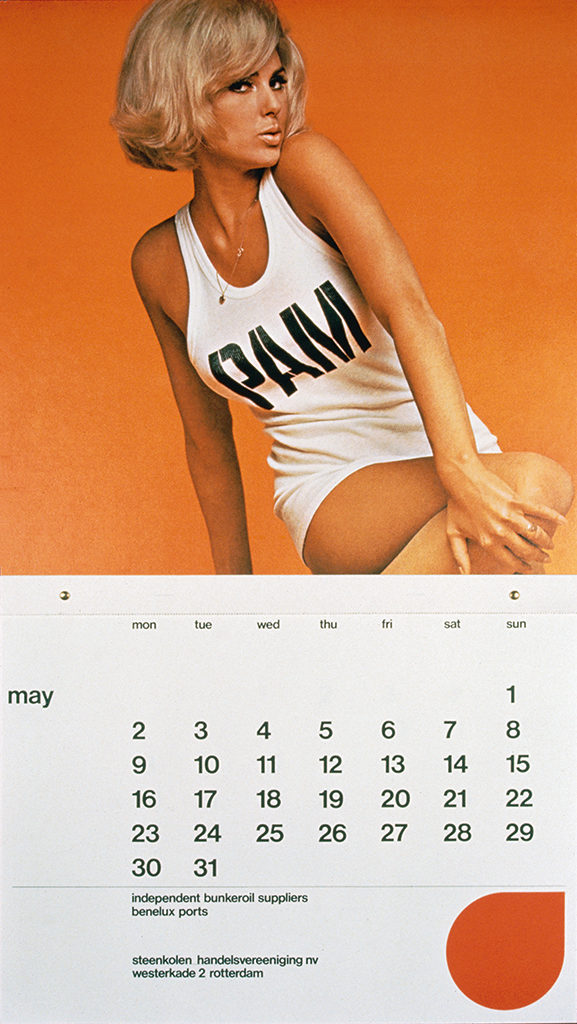
A few years prior Benno had made a monumental start for the substantial and bold corporate identity for PAM gasoline and liquid gas (1964). Suddenly the roadsides are dressed-up with squeaky-clean gas stations and gorgeous transport vehicles. For this commission Benno tenders the production to André Kwee of Omnimark. There are white tankers for gasoline, black ones for heavy fuels, all with the strong, geometrically stylized red drop. In its wake follow designs for a large succession of larger and smaller SHV subsidiaries, such as GTI, the Makro and naturally the parent company SHV. It all finishes with the encore Calpam, the fusion between Caltex and Pam. Oil storage tanks, road and rail transport were visible and prettier than ever before. The SHV packaged the last of the Dutch home heating coal in Benno’s white paper bags.
It is also the time of house style manuals and of course, as usual, Benno takes the lead. He develops wayfinding and signage systems for large event complexes such as the Martinihal in Groningen, the concert- and event halls Ahoy and De Doelen in Rotterdam, the Provincial House Zwolle, and a bus station for Tel Aviv. For some of these jobs Benno and his collaborators design specialty fonts. For De Doelen he also designs the logo, programs, and record jackets. He puts a new layout and production method on track for the opinion magazine Haagse Post (HP). The production times are shortened such that, after the weekend, additional pages can be delivered thus increasing the actuality of the articles.
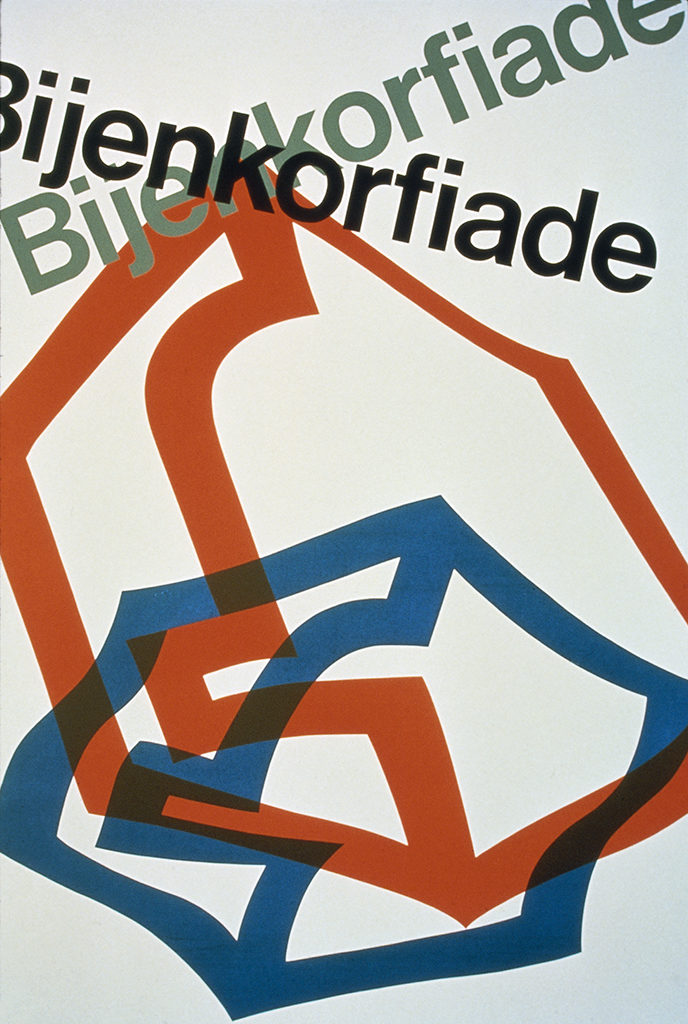
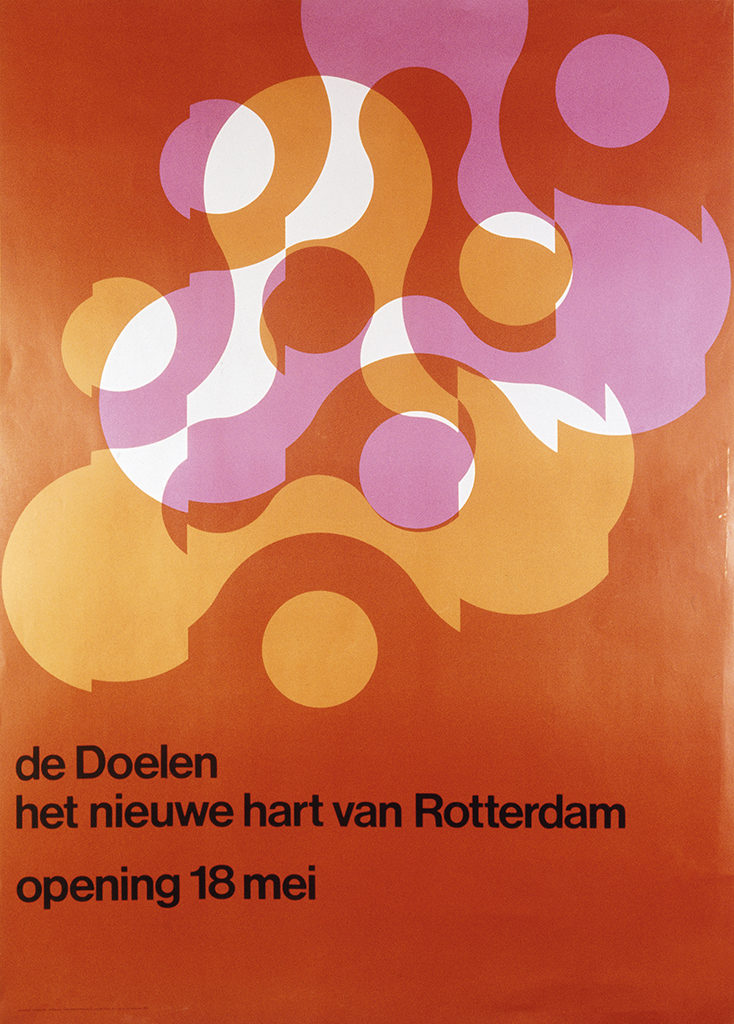
He keeps busy with the building of the apothecary of Vasbinder in Rotterdam and of Romijn in Zaandam. His storage systems for medication are remarkably practical. Benno drafts a revolutionary shop interior for Schmidt Opticians in Amsterdam. The first one, situated in a gallery of shops on the Rembrandsplein, owned by the developer Maup Caransa, unfortunately closes prematurely. Sometime later there is a repechage in Buitenveldert; he designs unique display units with their own integrated lighting system. For the Bijenkorf Department store he designs posters, incidental periodicals, and packaging. He develops plans for the interior of the large library of the Medical School of the Erasmus University, including its furniture and carpeting. For his graphic productions Benno tenders as usual top quality printers. Included are the printers Meyer in Wormerveer, Plantijn in Rotterdam, Lecturis in Eindhoven, Rosbeek in Nuth. When he is ‘on-press’ he is a challenge.
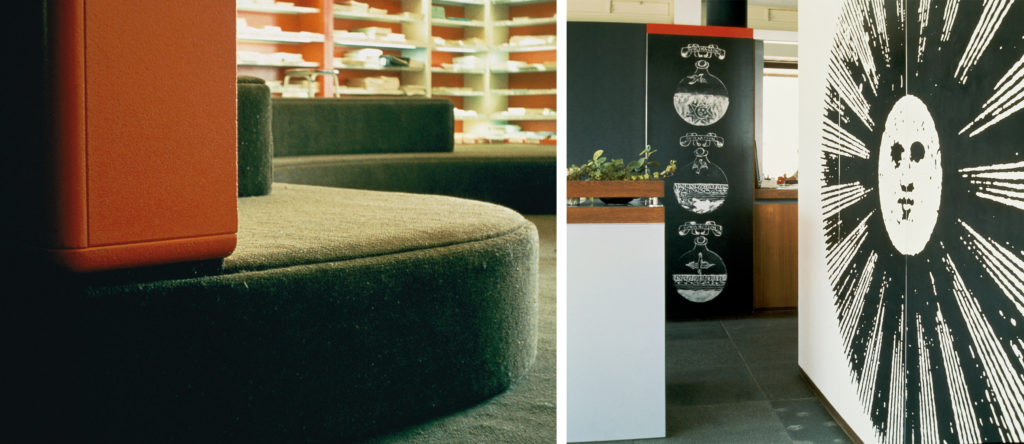
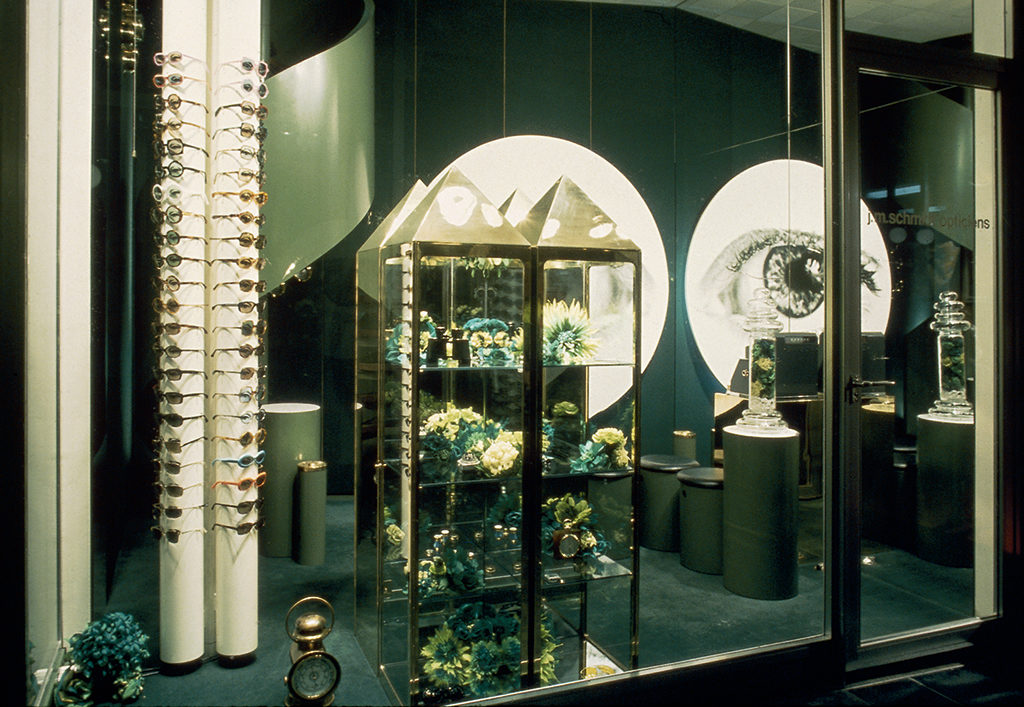
It is 1968. Activists like the Provos of Amsterdam, say their piece, squatters take over empty buildings, and radical students occupy the administrative building of the University of Amsterdam. Students in Paris man the barricades. Everywhere, autocratic regents come under severe criticism and are put to the test. Suddenly, Benno’s time-tested militant nature reawakens big time. He expresses his frustration with the rank order and power distribution within the management of Total Design, which he experiences as the struggle between design and capital. The foundations of Total Design shake. On the Veluwe heath, in long retreats, the partners talk a lot with- and past one another. Bombs burst everywhere and the Schwartz brothers depart. Quietly and deliberately Benno prepares for his resignation. Benno the poet finds fiery words to settle old scores.
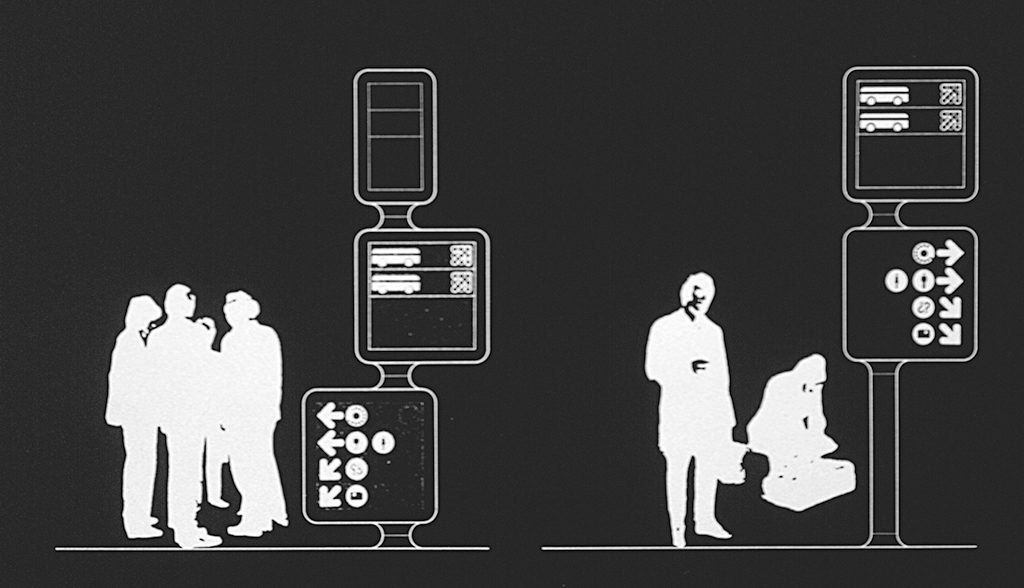
In 1972 he starts his own office with Hartmut Kowalke. Another two from TD, John Stegmeijer and Anne Stienstra are recruited. They make beautiful things for the Utrechtse Stadschouwburg (Utrecht City Theater) and the Utrecht Centraal Museum. . They design elaborate annual reports and international presentations for the city and harbor of Rotterdam. Inspired by the dynamic 3-d models of the American Will Burtin, Benno, together with his Belgian AGI-friend Jacques Richez, design large interactive displays of the Belgian economy. Work for the SHV Corporation continues and there are commissions for the sugar company CSM. Suddenly the United States looms.
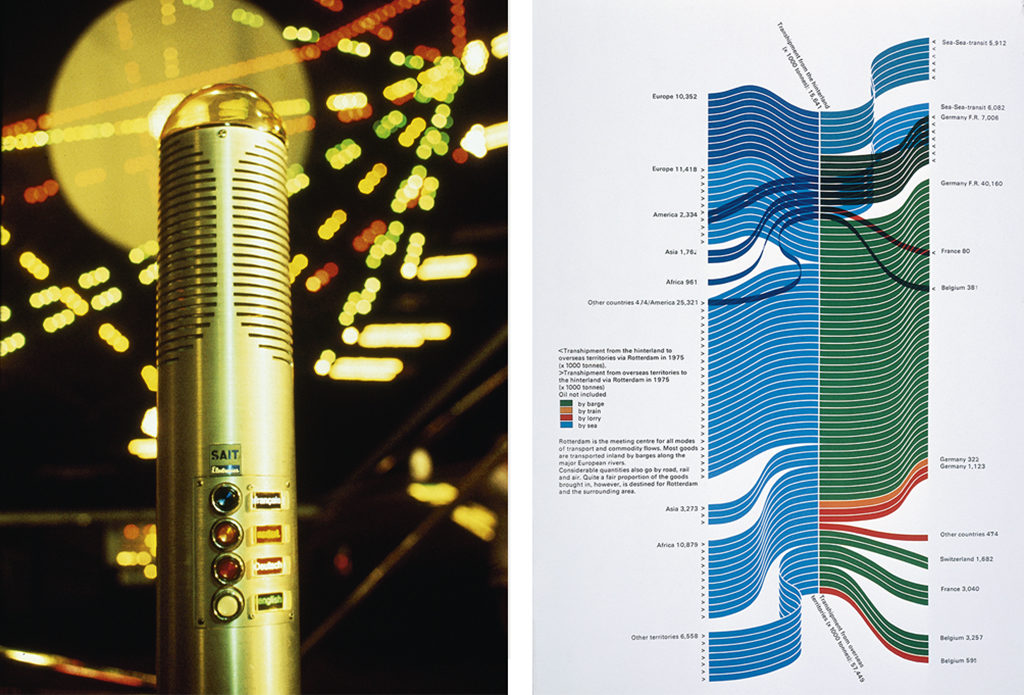
In 1978 Benno is offered a professorship at the famed Rhode Island School of Design (RISD) in Providence. A year later, with a series of posters and programs for the Holland Festival in the works, he has already started a totally new life in the New World. After his emigration – in 1980 – he continues with his work for the Holland Festival, supported in the Netherlands by John Stegmeyer, Jack Jacobs and Ben Duyvelshof. The image for the festival is of an intoxicating visual richness – Benno at his very best. Looking back it is hard to comprehend that this is all hand made, without the support of a computer. This party lasts until 1985. Moreover, 1985 is the year in which his professorship at RISD draws to a close. Benno can no longer reconcile the mismatch between the high college tuition and the consequential inability to remove underperforming or failing students. There again is Benno the idealist in collision with the capitalists. His association with his RISD-colleague and Providence designer Malcolm Grear stalls after two years (1980-1982). He continues on his own with the designer Peter Gengler.
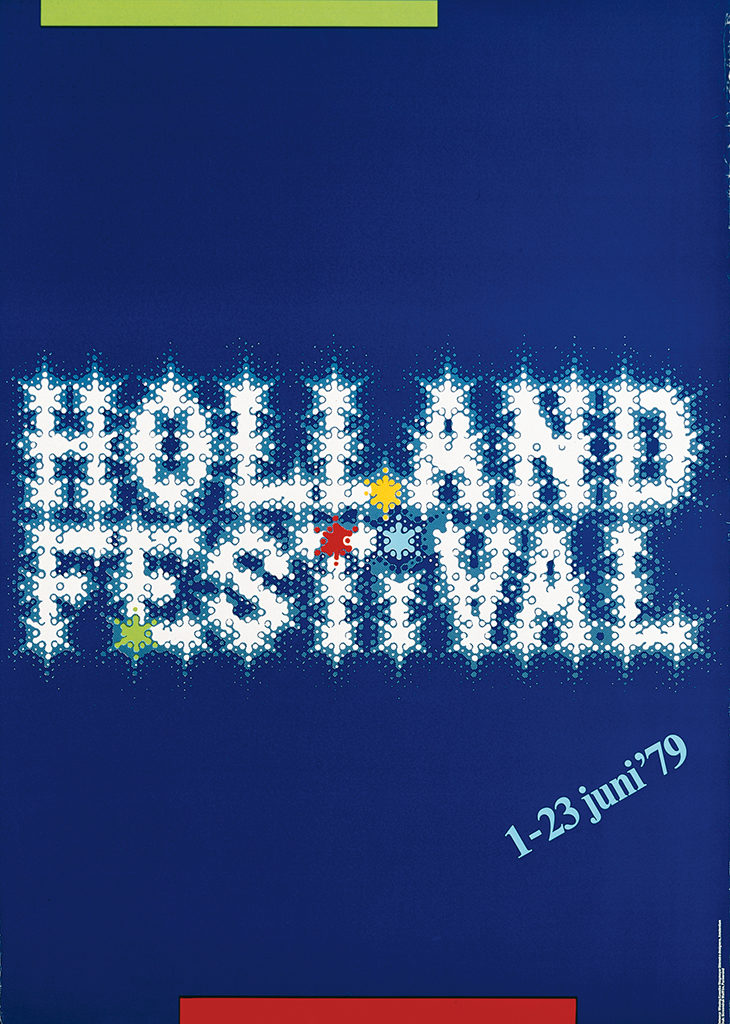
The American practice yields many remarkable results. They don’t receive much notice in the distant mother country. Benno disappears almost entirely from view. It starts with a beautiful publication for the Austin Company of Cleveland. It fits within the tradition of Benno’s earlier corporate publication 4 gaten in de grond and the one for Grasso. Superb photography embedded in a successful and high quality design. There are projects for the Partners of the Americas and the National Maritime Heritage Festival of Newport, Rhode Island. Governmental commissions arrive: identity design for the U.S Navy and signage for Rhode Island Hospital. The National Building Museum in Washington is next (1981)- for this he creates printed matter, interior design and signage. Many commissions arrive from a variety of architects and project agencies.
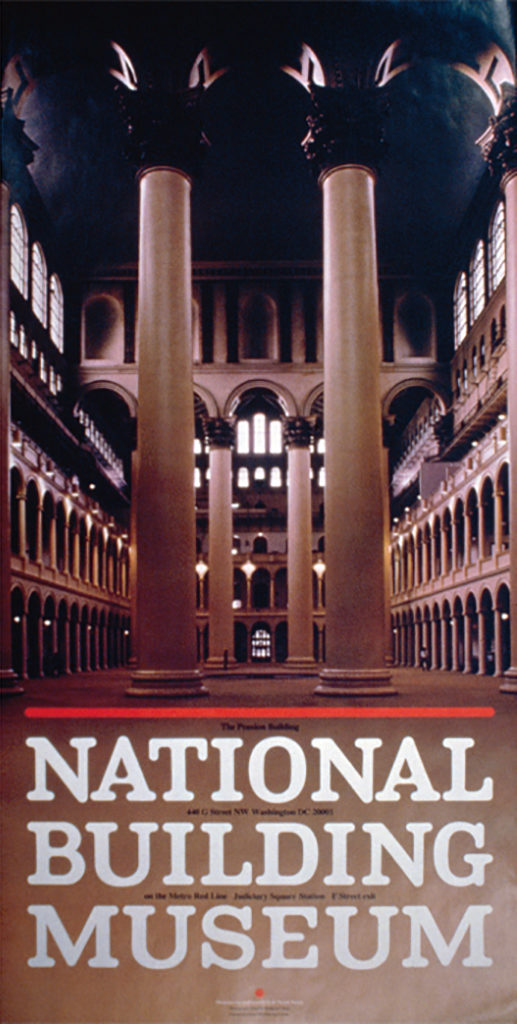
Wissing has a lasting involvement with the Kennedy Plaza Project in Providence – a wayfinding system for the RI Public Transport Authority. There is promotional material for the computer company Wang (1983-1985). The corporate identity project for the Women and Infants Hospital in Providence lasts three years. Wayfinding and signage design remains a mainstay for the partnership. They develop these systems for banks, corporate headquarters, Brown University and for a variety of industrial entities. There is rewarding work designing street furniture and for the renewal of blighted inner cities and sports venues.
In the middle of the 80s Benno signs-on for the design of the wayfinding system for the American Airlines Terminal at the airport of Raleigh/Durham in North Carolina in collaboration with the New York design firm Works (with Keith Godard and Hans van Dijk). The result is colorful, with a focus on ‘relaxation’ for the often-stressed passengers. From 1985 till 1988 Benno is the industrial designer tasked with the development of digital compasses. They are intended for dashboard build-ins on sail- and powerboats as well as for free-hand operation. They are innovative bestsellers; even to the degree that is allows his client KVH Industries a listing on the stock exchange.
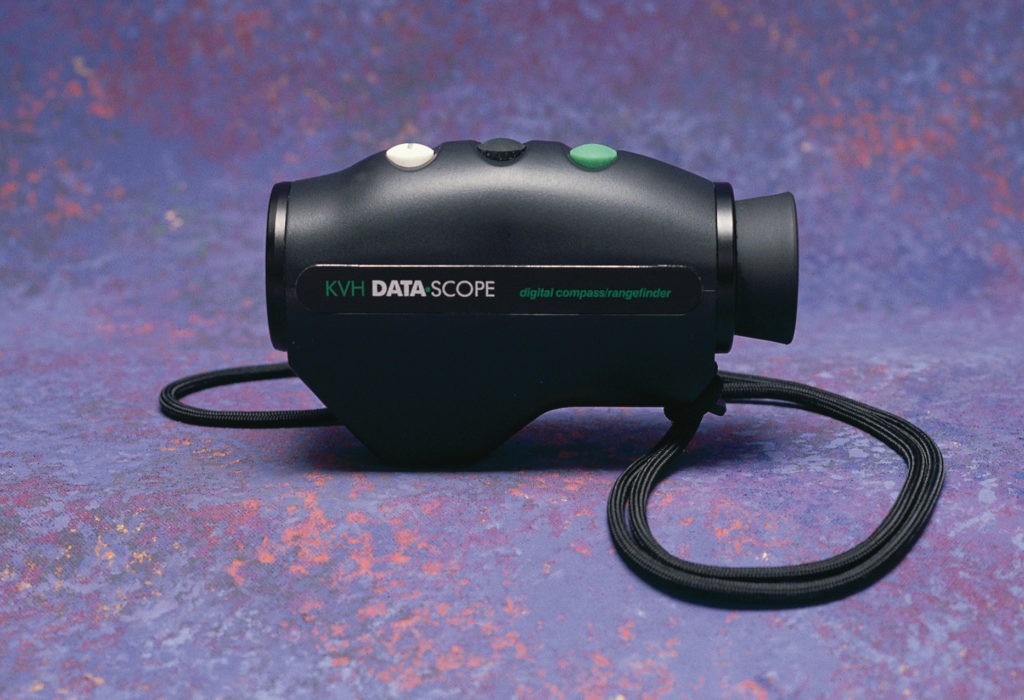
His health markedly failing, Benno is forced to withdraw from his practice and he retires to Bristol on the Narragansett Bay. With his willpower and the infinite efforts of Jannie he battles, often with appreciable success, his disabilities. With just one hand he picks up his art that he abandoned in the 1940s, and once again makes beautiful drawings and watercolors. The Dutch design community rediscovers him and recognition for his accomplishments and contributions to the Dutch design profession follow. In 1992, Benno is made an honorary member of the then professional association Nederlandse Ontwerpers (Dutch Design Association, first bNO and now BNO). He is offered, in April of 1993, a modest exhibition in the new wing of the Stedelijk Museum together with his Amsterdam colleague Jan Bons (also a brand-new honoree). This evolves for Benno into an emotional reunion with many old friends that had dropped from view. The BNO produces a modest publication.
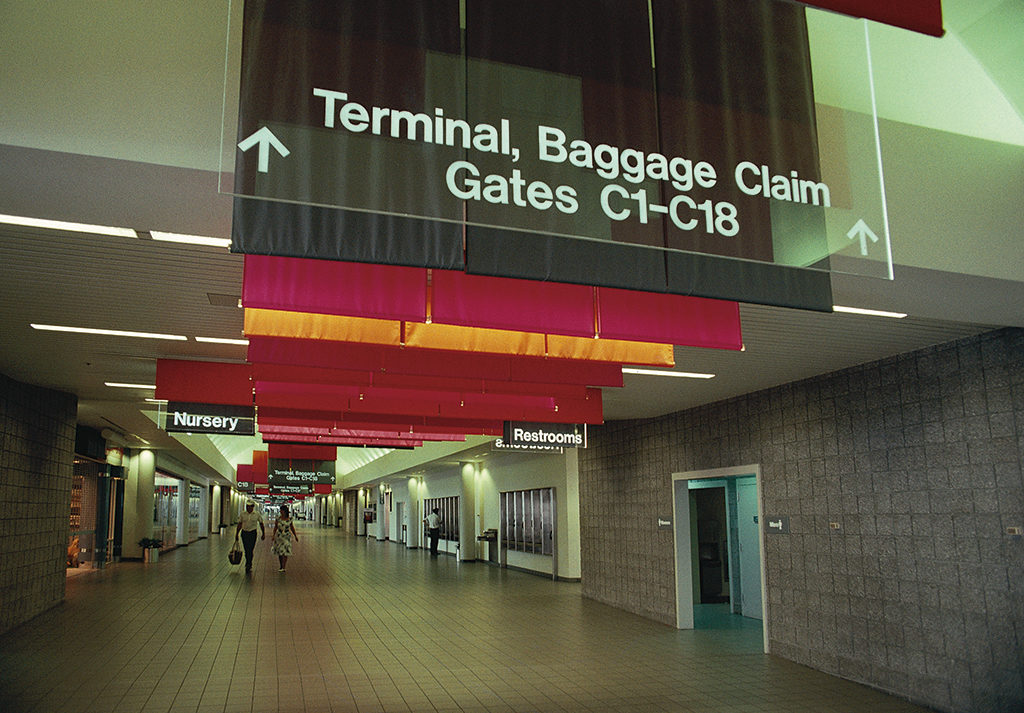
American Airlines hub terminal, with design group Works, New York City
In 1996 he receives the prestigious Oeuvre Award from the Stichting fonds voor beeldende kunsten, vormgeving and bouwkunst (Netherlands Foundation for Fine Arts, Design and Architecture). It is reason for another grand party in the Stedelijk Museum. Paul Hefting writes the accompanying monograph stylishly designed by Mart Warmerdam. Museum Boymans-van Beuningen remembers Wissing with an exhibit about his significance for the museum. Once more his posters, catalogues and installations are on view. In the framework of the 150th anniversary of the museum (1999) Dingenus van de Vrie, of Boymans’ communications department writes, together with Paul Hefting and Koosje Sierman, the monograph Benno Wissing, grafische en ruimtelijke vormgeving (Benno Wissing, graphic and spatial design). 2D3D takes care of the design.
When in 2003 ‘Total’ commemorates the 40 years that have passed since the foundation of TD Associatie voor Total Design, Benno is flown-in as a guest of honor.Like a retired prince he welcomes everyone in the conference room of Total Identity. Many of his former TD associates pass by and during the dinner he has a highly emotional and final get together with his old comrade André Kwee. And thus closes the circle of memories of the remarkable times of PAM, SHV and Schiphol.
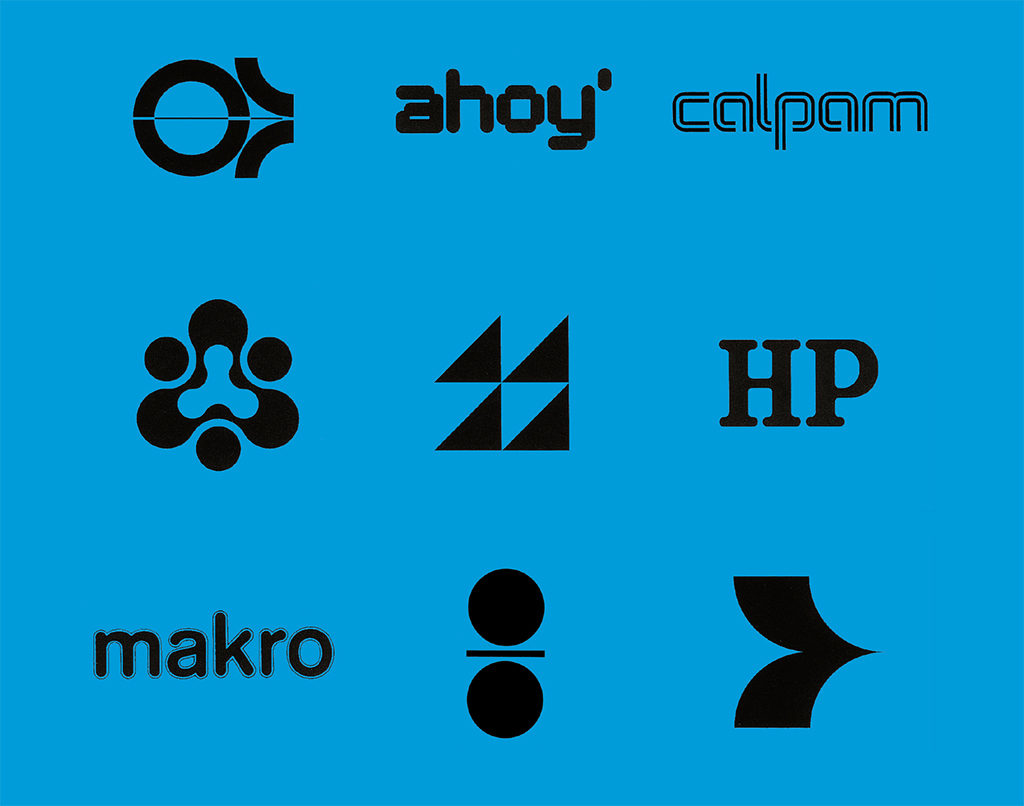
Benno Wissing
born on 26 May 1923, Renkum
died on 7 January 2008, Rhode Island (USA)
Author of the original text: Ben Bos, May 2006
English translation and editing: Hans van Dijk
Final editing: Sybrand Zijlstra
Portrait photo: Jan van Toorn
